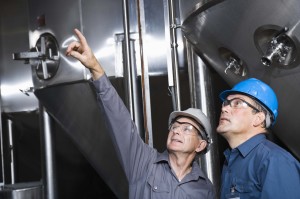The U.S. Census Bureau estimates that by 2016, one-third of the U.S. workforce will be age 50 or older and that number will increase to 115 million by 2020. A Pew Research report shows that approximately 10,000 Baby Boomers will turn 65 every day for the next 19 years. At this rate, almost every manufacturer in the U.S. can expect to lose some of their most senior workers.
These workers have the highest skills in operating your machines, and doing it safely. As you begin to fill positions once held by the long-time workers, the average age level of the workforce will get younger and less experienced in your facility. In 2013, there were approximately 18.1 million workers less than 24 years of age, and these workers represented 13% of the workforce. This shift will impact the safety culture of your manufacturing organization and potentially increase your operational costs due to injury.
Young workers have higher occupational injury rates, which are in part explained by a high frequency of hazards in workplaces where they typically work. The 2013 emergency room rate for the treatment of occupational injuries of young workers was approximately two times higher than that of workers 25 years and older. How do you start now to build a work environment that reduces the safety risks of your workers and protects your bottom line?
Adopting a New Future Vision
Looking at the current situation at your facility will help prepare the foundation for a stable, consistent safety culture to support the younger workforce. This requires a holistic approach to equipment, technology, and workforce.
- Conduct risk assessments of the work environment and equipment.
- Create a knowledge transfer process to effectively capture safety knowledge of your retirement age workforce.
- Implement a mentoring program to improve the skill level of your workforce
- Establish a formal training program for all employees
- Create a sustainable workforce with a Culture of Safety
Building a safety culture for the future is based on safety standards for manufacturing machinery, safety technology for automation and user friendly controls, and continuous safety training for the workforce.
This foundation helps you:
- Create a work environment for productive output while minimizing and reducing worker risk of injury
- Create a culture with the increased likelihood that Standard Operating Procedures will be followed
- Make machinery safer and easier to operate and maintain
- Reduce the motivation to bypass safety technology and procedures
As your aging workforce begins to exit your operation, you will have a safe, sustainable workforce for Continuity of Performance in the future.
 Training and Keeping the Future of Your Business
Training and Keeping the Future of Your Business
A CFO asks, “What happens if we invest in developing our people and then they leave us?” The CEO replies, “What happens if we don’t, and they stay?”
Similar to a 12-step program, the first step in addressing a problem is in accepting that you have a problem. When you’ve identified a skill gap in your workforce, you can begin to take steps in addressing the gap, but even then, other obstacles remain.
Weighing the Value of Training
While someone might believe that they have a skill problem, they may not think that hiring outside training is worth the investment. They can’t get beyond the idea that proper training will cost time and money. They understand that there probably is a long term benefit, but their incentives are tied to short term performance goals. Manufacturers continue to react to the problems they are experiencing rather than proactively preventing future problems.
There isn’t a Training Problem
If there is a skill problem, there is a training problem, but many manufacturers insist that their internal training is ‘good enough’. Many manufacturers believe that since they have skilled employees within the facility, the new, less skilled workers can learn from the more experienced workers if they are motivated and talented enough.
The problem here is that pointing fingers at your less skilled employees will not help them get up to speed with the more experienced workers. While your skilled workers certainly have the experience and technical knowledge, they don’t know how to teach people what they know because they aren’t professional trainers. For them, training is an additional obligation they are given when they are already crunched for time. They have their own performance goals to meet and training isn’t among them.
Change is one of the few certainties in life. This is present in every area in of our existence, and it’s certainly present in business. Risk typically follows closely behind. Without risk, there’s less change but also less potential reward. However, if you think through future actions and gather all the facts, you can better assess the dangers and potential benefits.
Recognizing Risk – Emerging Risks
We all experience risk every day in our decision making. The key is to make smart decisions, where the reward outweighs the risk. While reading the special report Managing Risk in Global Manufacturing Enterprises recently, I was surprised to discover that two of the top five emerging risks businesses are currently concerned about are skill shortage and an aging workforce. This is very interesting considering that these two categories are directly related to each other.
Knowing that these risks exist, it is important to make decisions that will minimize or even eliminate the risks. In most manufacturing organizations, the veteran employees generally contain the most skills and knowledge companies need to maintain and improve operations. According to the Industry Week report, 73% of proactive companies are concerned with not having the right information when assessing risk. Considering this large percentage it would make sense for these companies to send their experienced and upcoming employees back to school, or to additional training classes.
This decision would involve an initial investment of time and money, but the rewards would outweigh the risk if a training program is properly designed to enhance the production process and the training itself (classes, documentation, and reinforcing events) are designed around the employees’ needs when working within that process. According to Flexstudy.com an employee who gains the additional skills needed for a job offers better results for the company. This would reduce overall production time, offer a higher quality product or service, and give employees a better sense of self worth.
Risk vs. Reward
What role does the veteran employee play in the process and how could it benefit them? What could companies do with these employees and their experience? The reality is that the organization needs to keep them involved and use their acquired skills to train and mentor the less experienced employees.
According to the case study “Aging Workforce Drives On-Boarding” the best opportunity for veteran employees to help the organization is to engage in an Instructor Certification Program (ICP) and participate in training the upcoming employees. This is critical for a company to retain and grow the skills and talent that veteran workers have gained. The key with this approach is that the experienced employees receive the proper training methodologies in the ICP.
Another method for a company to utilize to retain – or bring back – knowledge and skills is having employees work part-time after retirement. This keeps the experienced employees close-by while the newer employees are learning. Often times retired employees welcome the opportunity to continue supporting the company while earning some additional money during their retirement
These different ideas relate back to Managing Risk. While reading the article Filling the Void Left by Baby-Boomer Techies I also realized the Baby Boomers are currently the largest work force in America. According to the article, “Every day 10,000 baby boomers turn 50. In the next 10 years, 43 percent of the workforce will be eligible for retirement, while the next two generations are about 15 percent smaller”. This proves that companies need to have a plan in place to transfer knowledge from the retiring employees to their upcoming employees. There is little to no risk investing in on-campus training. This transfers knowledge and keeps the veteran employees engaged in leaving a legacy at the company. Since we are approaching the peak of the Baby Boomer Generation in the work force arriving at retirement age, companies need to discover ways to make their employees more efficient and knowledgeable.
Managing Risk
Many people become nervous in life and because of this anxiety, do not make important decisions. This indecision relinquishes the ability to influence the outcome of a circumstance. When this happens others will step in and make decisions for you, good or bad, and you will be forced to respond. Years ago a business owner told me that a company not planning for success is planning for failure. That doesn’t represent leadership qualities of a strong company, and it is a risk that organizations do not need.
We discussed the fact that the largest workforce in America, the Baby Boomers, is quickly retiring its workforce – and we have yet to reach the peak of this generation’s retirement age. As these employees retire, the skills, knowledge, contacts, and overall foundation of a company is gone. According to the case study, “Aging Workforce Drives On-Boarding,” in the next 10 years 35% of a company’s staff will be retiring; in the follow 15-20 years companies will be impacted by 60%-70% of their employees retiring. Companies must prepare for these changes by implementing a plan to sustain or increase a new skilled set of employees. In these economic times, companies need every advantage they can get over their competitors. Knowledge and skill retention is a major one.
It takes days to learn a skill set, years to truly understand it, decades to master it, and one retirement party to lose it. Employees invest countless hours at work for their employers. Now it is time for companies to invest time and money back into their employees – their next generation of employees – and ensure the long-term success of both the employee and the company.
Unlocking Your Employees Hidden Assets
“Do what you can, with what you have, where you are.” – Theodore Roosevelt
 Have you had a hard time finding enough skilled talent to fill job openings, or worse, settled for under qualified employees? You aren’t alone. During the recession, students changed their degrees from engineering and manufacturing. As a result, the manufacturing industry is facing a shortage of skilled workers.
Have you had a hard time finding enough skilled talent to fill job openings, or worse, settled for under qualified employees? You aren’t alone. During the recession, students changed their degrees from engineering and manufacturing. As a result, the manufacturing industry is facing a shortage of skilled workers.
Experts believe it will take another five years before enough skilled workers will be graduating from universities to fill the gap. To make matters worse, your workforce is probably aging and when they retire, their knowledge and experience goes with them. While there has been a lot of emphasis on the lack of skilled workers that are entering the workforce, improving and closing gaps in existing skilled workers begs attention.
So, what can you do about it? Your best workers have learned how to make things work because of their history and experience and the next generation of workers can benefit if you take the right steps.
The Benefits of Proper Training
When manufacturers emphasize training, they experience long term gains and improvements in efficiency, personnel performance, equipment performance, and quality. It goes without saying that skilled employees enhance the entire work environment on many levels, but we know that investing in training will lead to less conflicts and quicker troubleshooting. Manufacturers who have implemented training programs rarely, if ever, backtrack. Instead, after starting with a small pilot group, training programs are expanded to engulf all operations. In 2015, manufacturers will be doubling down on workforce training.




